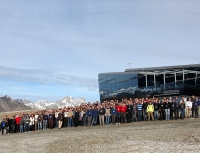
[2010-09-14] In Pardorama, situated 2600 m above sea level, in Ischgl/Tyrol, European researchers in the field of quantum matter meet to discuss the newest findings in one of the most exciting fields of research. The conference is funded by the European Science Foundation (ESF) and deals with the particular nature of ultracold quantum matter.
In the last few years, ultracold quantum matter has become one of the most fascinating fields of research in physics. Experimental physicist are now able to control or tune single particles or clouds of particles experimentally in such a way that they can observe new states of matter, which have so far been predicted in theory only. For example, scientists have succeeded in merging atoms at a temperature close to absolute zero to form molecules and transferring these molecules to a Bose-Einstein condensate. In this new state of matter all particles behave in the same way, forming a single quantum object. These experiments not only provide new insights into the physical properties of matter but also open up new exciting possibilities of applications such as high-precision measurement tools and quantum computation.
About 200 scientists coming from Europe, USA, Australia and other countries meet at the conference in Ischgl. Prof. Deborah Jin from the Joint Institute for Laboratory Astrophysics (JILA) of the University of Colorado, Boulder and leading researcher in the field of ultracold quantum matter opened the conference with a key note speech. “A large part of the research community is assembled at this conference, and we discuss and review current questions and future prospects for research,“ says Rudolf Grimm, head of the newly founded main research topic Physics (Innsbruck Physics Research Center) at the University of Innsbruck and organizer of the EuroQUAM conference. “This is an important moment for this relatively young and highly complex field of research.”
Under the project EuroQUAM, which connects theoretical and experimental research, leading European research groups in quantum matter are linked. “In this network, we can take advantage of the entire European potential in this seminal field of research,” says an excited Rudolf Grimm about the cross-border collaboration. The 3-year project is funded under the EUROCORES program by the European Science Foundation. The EuroQUAM concluding conference taking place in Ischgl/Tyrol is organized by the Innsbruck Physics Research Center of the University of Innsbruck and the Institute for Quantum Optics and Quantum Information (IQOQI) of the Austrian Academy of Sciences.
The European Science Foundation (ESF) is an independent, non-governmental organization promoting collaboration in scientific research, research funding and science policy across Europe. Established in 1974, it represents 79 national funding bodies, research institutions, academies and scientific societies from 30 countries. The ESF serves as a common platform for cross-border cooperation in Europe and has made major contributions to science on a global scale. EUROCORES is an ESF program promoting interdisciplinary collaboration of European, American and Canadian researchers within the framework of interdisciplinary joint research projects